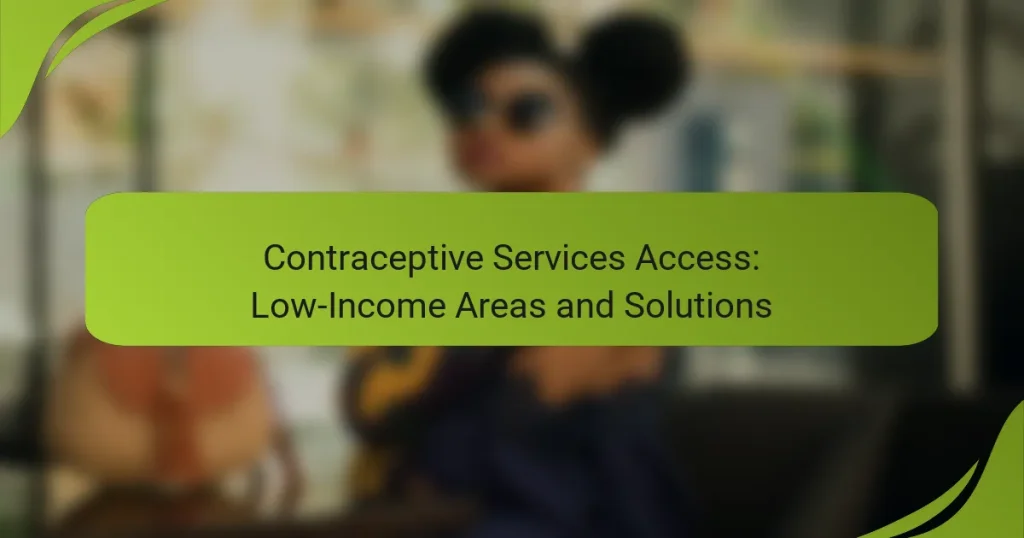Access to contraceptive services in low-income areas remains a critical issue, often hindered by financial constraints and limited availability. Implementing solutions such as community health clinics, telehealth services, and mobile health units can significantly improve access and ensure that individuals receive the reproductive health care they need. By fostering partnerships with local organizations and leveraging government support, these strategies can create a more equitable landscape for contraceptive access.
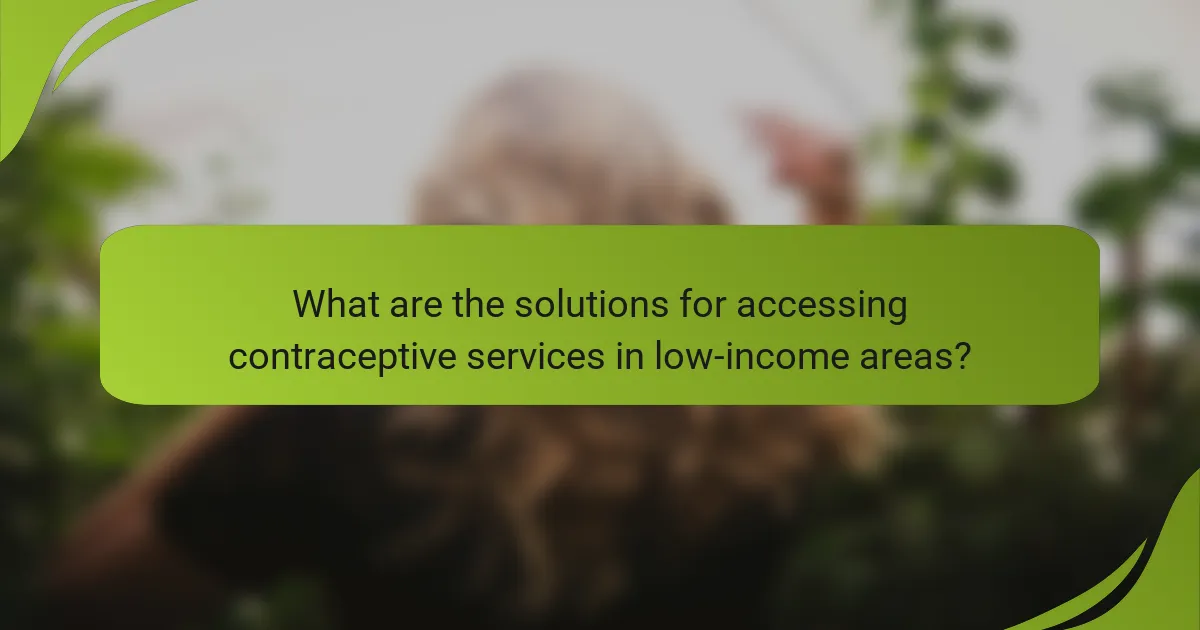
What are the solutions for accessing contraceptive services in low-income areas?
Accessing contraceptive services in low-income areas can be improved through various solutions that focus on affordability, availability, and community engagement. Key strategies include establishing community health clinics, utilizing telehealth services, deploying mobile health units, forming partnerships with local organizations, and implementing government-funded programs.
Community health clinics
Community health clinics play a vital role in providing affordable contraceptive services to low-income populations. These clinics often offer a sliding scale for fees based on income, ensuring that individuals can access necessary services without financial burden.
Many clinics provide a range of contraceptive options, including pills, IUDs, and condoms, along with counseling services. It’s essential to locate clinics that are certified and adhere to local health regulations to ensure quality care.
Telehealth services
Telehealth services have emerged as a convenient solution for accessing contraceptive care, especially in remote or underserved areas. Patients can consult healthcare providers via video calls or phone consultations, making it easier to receive prescriptions and advice without needing to travel.
When using telehealth, ensure that the service is reputable and that providers are licensed in your state or country. Many telehealth platforms also offer discreet delivery of contraceptives, further enhancing accessibility.
Mobile health units
Mobile health units are essential for reaching individuals in low-income areas who may lack transportation. These units travel to various locations, providing on-site contraceptive services, education, and health screenings.
Mobile units can be particularly effective during community events or in areas with limited healthcare facilities. They often collaborate with local organizations to identify high-need areas and schedule visits accordingly.
Partnerships with local organizations
Forming partnerships with local organizations can significantly enhance access to contraceptive services. Nonprofits, schools, and community groups can help raise awareness and provide resources to those in need.
Collaborative efforts may include educational workshops, distribution of contraceptives, and referral services. Engaging trusted community leaders can also help reduce stigma and encourage individuals to seek care.
Government-funded programs
Government-funded programs are crucial in providing contraceptive services to low-income populations. These programs often cover the cost of contraceptives and related healthcare services, making them accessible to those who might otherwise forgo care.
Eligibility for these programs typically depends on income level and residency. It’s important to stay informed about local and national initiatives that can provide financial assistance or free services to individuals seeking contraceptive options.
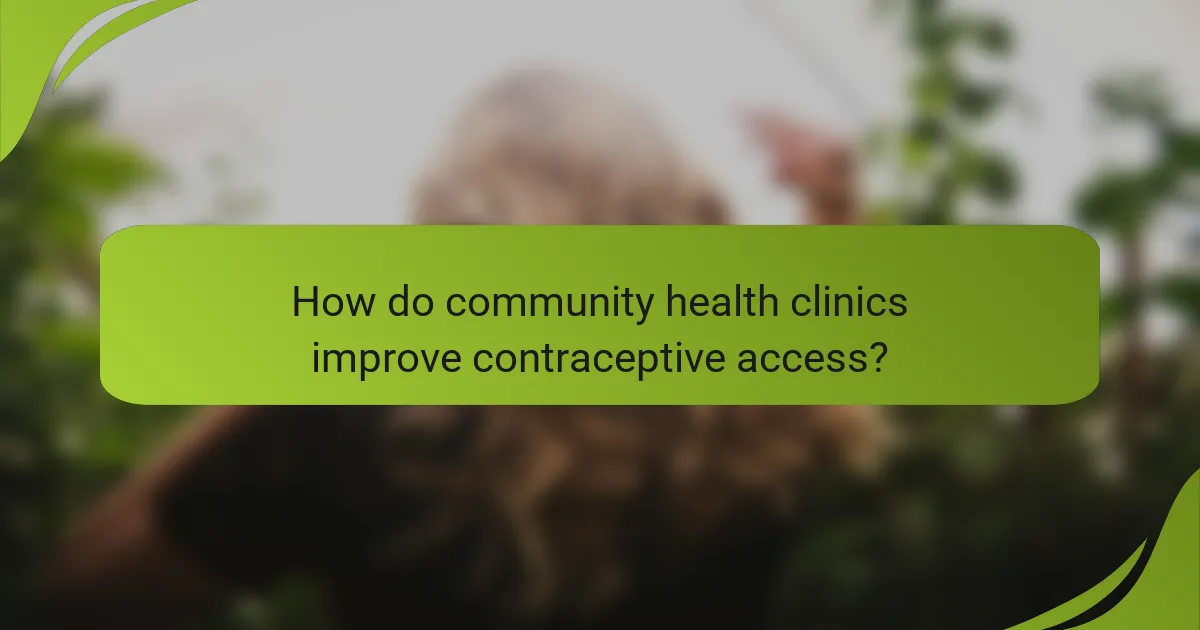
How do community health clinics improve contraceptive access?
Community health clinics enhance contraceptive access by providing affordable and comprehensive reproductive health services to low-income populations. These clinics often serve as a vital resource, ensuring that individuals can obtain necessary contraceptive methods without financial barriers.
Affordable services
Community health clinics typically offer contraceptive services at reduced costs or on a sliding scale based on income. This pricing model makes it feasible for low-income individuals to access birth control methods that might otherwise be unaffordable.
Many clinics accept various forms of insurance, including Medicaid, which can further alleviate financial burdens. For those without insurance, clinics may provide free or low-cost options, ensuring that everyone has the opportunity to prevent unintended pregnancies.
Comprehensive care
In addition to contraceptive services, community health clinics provide a range of reproductive health care, including STI testing, pregnancy counseling, and general health screenings. This holistic approach ensures that patients receive well-rounded care tailored to their needs.
By offering comprehensive care, these clinics can address underlying health issues that may affect contraceptive use, such as hormonal imbalances or chronic conditions. This integrated model promotes better health outcomes and empowers individuals to make informed choices about their reproductive health.
Local outreach initiatives
Community health clinics often engage in local outreach initiatives to raise awareness about available contraceptive services. These initiatives may include educational workshops, health fairs, and partnerships with local organizations to reach underserved populations.
Through targeted outreach, clinics can inform individuals about their contraceptive options and the importance of reproductive health. This proactive approach helps to reduce stigma and encourages more people to seek the services they need, ultimately improving access to contraception in low-income areas.
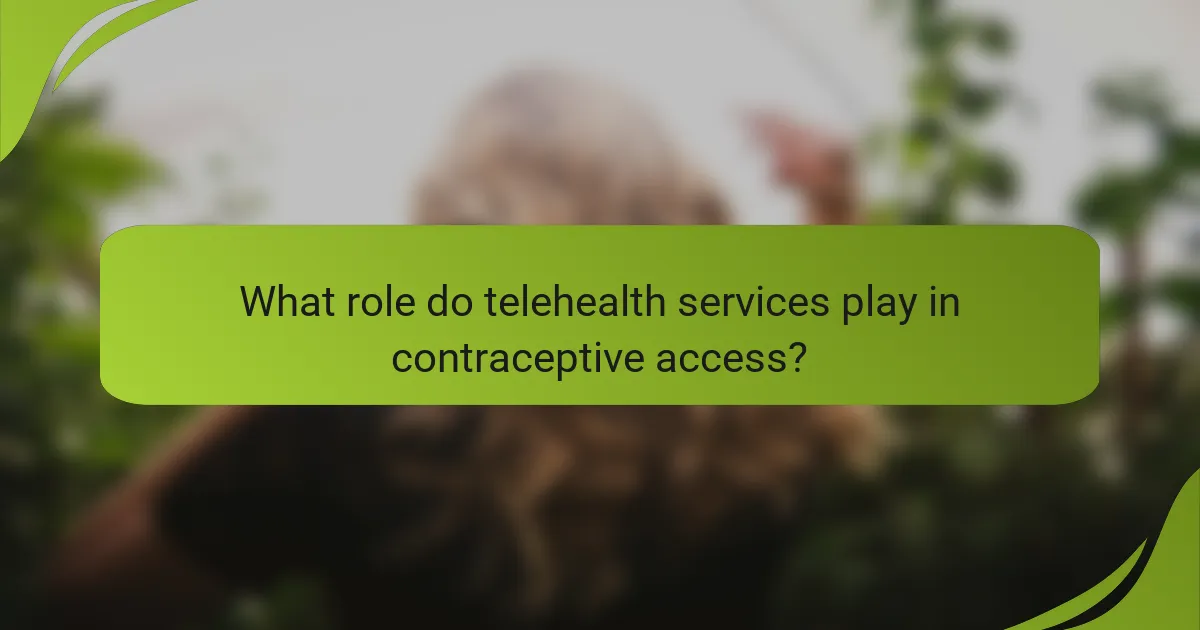
What role do telehealth services play in contraceptive access?
Telehealth services significantly enhance access to contraceptive options, especially in low-income areas. They provide a convenient platform for individuals to consult healthcare professionals, obtain prescriptions, and manage their reproductive health without the barriers of transportation or long wait times.
Remote consultations
Remote consultations allow patients to connect with healthcare providers through video calls or phone calls, making it easier to discuss contraceptive needs. This method is particularly beneficial for individuals in low-income areas who may lack nearby clinics or face transportation challenges.
During these consultations, patients can receive personalized advice on various contraceptive methods, including hormonal options, IUDs, and barrier methods. It’s essential to prepare questions in advance to make the most of the limited consultation time.
Prescription delivery options
Many telehealth services offer prescription delivery, which ensures that contraceptives can be sent directly to a patient’s home. This option eliminates the need to visit a pharmacy, which can be a significant barrier for those in low-income areas.
Patients should verify if their telehealth provider partners with local pharmacies or delivery services to ensure timely access to their prescriptions. Some services may also offer discounts or accept insurance, making this option more affordable.
Increased privacy
Telehealth services provide increased privacy for individuals seeking contraceptive care, which can be crucial in conservative or stigmatizing environments. Patients can discuss their needs from the comfort of their homes, reducing the fear of judgment or exposure.
To maintain privacy, it is advisable to choose a secure and confidential platform for consultations. Patients should also be aware of their rights regarding medical confidentiality and inquire about how their information will be protected during the process.

What are the barriers to contraceptive access in low-income areas?
Barriers to contraceptive access in low-income areas include transportation issues, financial constraints, and limited health education. These obstacles can significantly hinder individuals’ ability to obtain necessary contraceptive services, impacting their reproductive health and overall well-being.
Lack of transportation
Many individuals in low-income areas face challenges in accessing transportation, which can prevent them from reaching healthcare facilities that provide contraceptive services. Public transport options may be limited, and personal vehicles might not be affordable or available.
To mitigate this barrier, community organizations can offer transportation assistance or mobile clinics that bring services directly to underserved neighborhoods. This approach helps ensure that individuals can access the care they need without the added stress of travel logistics.
Financial constraints
Financial barriers are a significant hurdle for many seeking contraceptive services in low-income areas. The cost of contraceptives, coupled with potential fees for medical consultations, can be prohibitive for those with limited income.
To address these financial constraints, programs offering subsidized or free contraceptive options can be vital. Additionally, educating individuals about insurance coverage for contraceptive services can help them utilize available resources effectively.
Limited health education
A lack of comprehensive health education in low-income areas often leads to misinformation about contraceptive options and reproductive health. Many individuals may not be aware of the various methods available or how to access them.
Enhancing health education through community workshops and school programs can empower individuals with the knowledge they need. Providing clear, accessible information about contraceptive methods and their benefits can help reduce stigma and encourage informed decision-making.
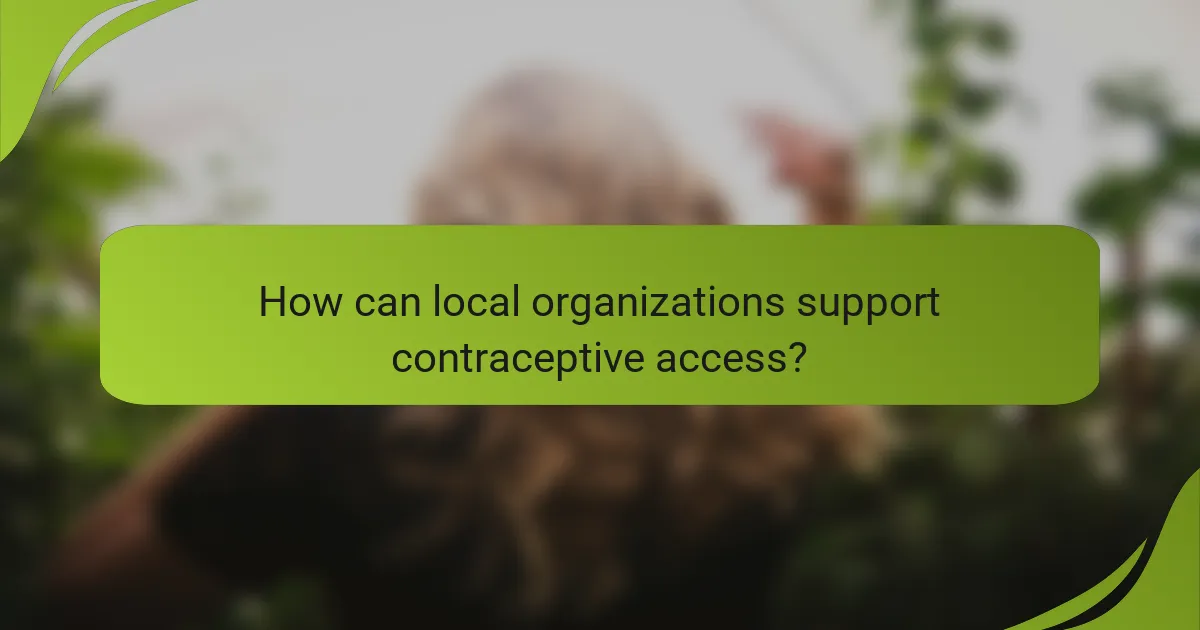
How can local organizations support contraceptive access?
Local organizations can enhance contraceptive access by implementing targeted programs that address the unique needs of low-income communities. These initiatives often focus on education, resource distribution, and partnerships with healthcare providers to ensure that contraceptive options are available and understood.
Awareness campaigns
Awareness campaigns play a crucial role in informing low-income populations about available contraceptive services. These campaigns can utilize various media platforms, including social media, local radio, and community events, to reach a broader audience and dispel myths surrounding contraceptive use.
Effective campaigns should highlight the benefits of contraceptive access, such as improved health outcomes and family planning. Collaborating with local influencers and healthcare professionals can enhance credibility and encourage community engagement.
Organizations should consider tailoring messages to reflect cultural sensitivities and local languages. Providing clear information on where to obtain contraceptives and the types available can empower individuals to make informed choices about their reproductive health.
